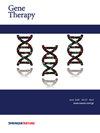Optimization of adeno-associated viral (AAV) gene therapies vectors for balancing efficacy, longevity and safety for clinical application
IF 4.5
3区 医学
Q1 BIOCHEMISTRY & MOLECULAR BIOLOGY
引用次数: 0
Abstract
Adeno-associated viral (AAV) vectors are an ideal platform for gene therapy due to their ability to deliver therapeutic cargos safely and effectively across various target organs. Their low immunogenicity contributes to long-lasting therapeutic effects. However, recent insights highlight the significance of CpG content within AAV vectors, where unmethylated CpG dinucleotides can trigger a TLR9-mediated immune response, leading to the rapid elimination of transduced cells. Clinical evidence indicates an inverse relationship between CpG content and therapeutic success, with lower CpG counts correlating with sustained transgene expression. Here, we sought to optimize a novel, CpG-rich AAV8 vector, referred to as pVR59, designed for treating lipoprotein lipase deficiency (LPLD). We strategically reduced CpG levels in pVR59, resulting in the development of pNC182, a CpG-depleted vector that maintains therapeutic efficacy. A single intramuscular injection of pNC182 demonstrated comparable effectiveness to pVR59 in normalizing lipemia and hypertriglyceridemia in LPLD mouse models, with a 38% reduction in total CpG count. These findings support the clinical application of pNC182 as a safe, long-lasting AAV gene therapy for LPLD and provide a framework for future AAV vector designs aimed at maximizing therapeutic efficacy while minimizing immunogenic responses in human settings.

腺相关病毒(AAV)基因治疗载体的优化,以平衡临床应用的疗效、寿命和安全性。
腺相关病毒(AAV)载体是基因治疗的理想平台,因为它们能够安全有效地在各种靶器官之间传递治疗货物。它们的低免疫原性有助于持久的治疗效果。然而,最近的见解强调了AAV载体中CpG含量的重要性,其中未甲基化的CpG二核苷酸可以触发tlr9介导的免疫反应,导致转导细胞的快速消除。临床证据表明,CpG含量与治疗成功呈反比关系,较低的CpG计数与持续的转基因表达相关。在这里,我们试图优化一种新的,富含cpg的AAV8载体,称为pVR59,设计用于治疗脂蛋白脂肪酶缺乏症(LPLD)。我们战略性地降低了pVR59中的CpG水平,从而开发了pNC182,这是一种保持治疗效果的CpG缺失载体。在LPLD小鼠模型中,单次肌肉注射pNC182在使血脂和高甘油三酯血症正常化方面显示出与pVR59相当的有效性,总CpG计数减少38%。这些发现支持了pNC182作为一种安全、持久的AAV基因治疗LPLD的临床应用,并为未来AAV载体设计提供了框架,旨在最大限度地提高治疗效果,同时减少人类环境中的免疫原性反应。
本文章由计算机程序翻译,如有差异,请以英文原文为准。
求助全文
约1分钟内获得全文
求助全文
来源期刊

Gene Therapy
医学-生化与分子生物学
CiteScore
9.70
自引率
2.00%
发文量
67
审稿时长
4-8 weeks
期刊介绍:
Gene Therapy covers both the research and clinical applications of novel therapeutic techniques based on a genetic component. Over the last few decades, significant advances in technologies ranging from identifying novel genetic targets that cause disease through to clinical studies, which show therapeutic benefit, have elevated this multidisciplinary field to the forefront of modern medicine.
 求助内容:
求助内容: 应助结果提醒方式:
应助结果提醒方式:


